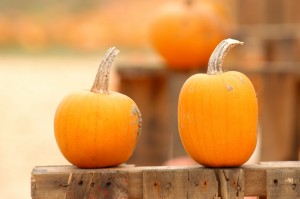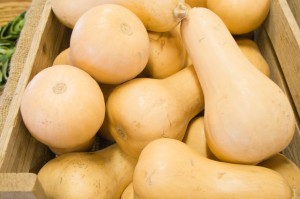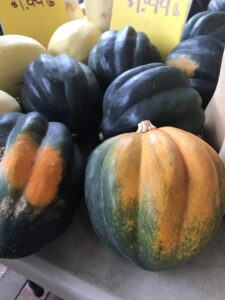Now at the farmers’ market in a variety of shapes, colors, stripes, and sizes, winter squashes are a seasonal staple. An excellent source of fiber and incredibly versatile, winter squash stored in a cool place will keep for up to 2 months.
 Let’s start with Spaghetti squash just because it is so fun and easy. I cut a Spaghetti squash in half and place it flesh-down on a well-oiled baking sheet at 400° for 30 to 40 minutes, or until fork tender. Once cooked, I scoop the flesh out with a fork. Magically, it separates into pasta-like strands, making a delicious gluten-free substitute for pasta. I top spaghetti squash with tomato sauce and meatballs or simply combine it with chopped fresh herbs, Parmesan cheese, salt, pepper and olive oil.
Let’s start with Spaghetti squash just because it is so fun and easy. I cut a Spaghetti squash in half and place it flesh-down on a well-oiled baking sheet at 400° for 30 to 40 minutes, or until fork tender. Once cooked, I scoop the flesh out with a fork. Magically, it separates into pasta-like strands, making a delicious gluten-free substitute for pasta. I top spaghetti squash with tomato sauce and meatballs or simply combine it with chopped fresh herbs, Parmesan cheese, salt, pepper and olive oil.
 Pumpkin, can be used for a variety of dishes. To make your own pumpkin purée, purchase small pie pumpkins and cut them into eighths. Remove the seeds, but don’t peel them yet. Put them on a baking sheet in a 400° oven for about 45 minutes or until they are fork tender. Once they cool a bit, the skin comes right off, just scrape it with the back of a knife. At this point, you can purée the pumpkin in a food processor or in a large bowl using a stick blender. You may need to add water by the tablespoon in order to achieve your desired consistency. The purée is now ready to be used in recipes or it can be portioned into freezer bags and frozen for future use in soups, quick breads, muffins or pie. It’s so delicious and good for you!
Pumpkin, can be used for a variety of dishes. To make your own pumpkin purée, purchase small pie pumpkins and cut them into eighths. Remove the seeds, but don’t peel them yet. Put them on a baking sheet in a 400° oven for about 45 minutes or until they are fork tender. Once they cool a bit, the skin comes right off, just scrape it with the back of a knife. At this point, you can purée the pumpkin in a food processor or in a large bowl using a stick blender. You may need to add water by the tablespoon in order to achieve your desired consistency. The purée is now ready to be used in recipes or it can be portioned into freezer bags and frozen for future use in soups, quick breads, muffins or pie. It’s so delicious and good for you!
Pear-shaped Butternut squash, with pale orange skin, can be used as a substitute for pumpkin in most recipes. I love it simply roasted. Use the method described above to peel and halve the  squash. Remove the seeds and chop the remaining squash into chunks. Toss it with olive oil, salt and pepper and lay it in a single layer on a large sheet pan. Roast the squash at 400° for about 20 minutes, depending on the size of your chunks. Stir them every 5 minutes or so. The natural sugars will caramelize, making the squash a delightful combination of crunchy and creamy. So delicious! Butternut squash also lends itself well to soups, like this Butternut Apple Bisque. Perfect for fall!
squash. Remove the seeds and chop the remaining squash into chunks. Toss it with olive oil, salt and pepper and lay it in a single layer on a large sheet pan. Roast the squash at 400° for about 20 minutes, depending on the size of your chunks. Stir them every 5 minutes or so. The natural sugars will caramelize, making the squash a delightful combination of crunchy and creamy. So delicious! Butternut squash also lends itself well to soups, like this Butternut Apple Bisque. Perfect for fall!
 Delicata squash is a delight. Distinctively yellow with green stripes, this small, oblong squash has a soft, edible skin. All you have to do is cut the squash in half lengthwise and remove the seeds. Then cut each half into ½-inch segments. Toss them in olive oil and season with salt and pepper. Place them on a baking sheet and roast them at 400 ° for about 20-25 minutes, turning them once. You know they are ready if they have started to brown and have become fork tender. Creamy and delicious, they remind me of a sweet potato.
Delicata squash is a delight. Distinctively yellow with green stripes, this small, oblong squash has a soft, edible skin. All you have to do is cut the squash in half lengthwise and remove the seeds. Then cut each half into ½-inch segments. Toss them in olive oil and season with salt and pepper. Place them on a baking sheet and roast them at 400 ° for about 20-25 minutes, turning them once. You know they are ready if they have started to brown and have become fork tender. Creamy and delicious, they remind me of a sweet potato.
Acorn squash are small and heart-shaped. Their shape makes them perfect for stuffing. They are also delicious halved, seeded and roasted. Serve them roasted, on a platter, with a little butter, salt and pepper.
Before I go, let me make the case for using your very best knife and knife skills for cutting into a squash. Repeat after me – a sharp knife is a safe knife. A dull knife is difficult to use, requires brute force (dangerous!), and can cause something like a squash to roll underneath it.
Knowing how to approach different tasks using a knife safely can keep you from harm, especially when it comes to cutting something large and irregular like a squash. Some squash have incredibly hard skins, making them even more difficult to cut. It helps to soften them up in the microwave. Take a fork and poke a few holes all around the exterior of the squash. Put it in the microwave for 1 minute, until slightly more tender, but not cooked. Use a (sharp!) chef’s knife to slice the ends off of the squash. At this point, it is relatively easy to peel the squash using a vegetable peeler and to cut the squash in half by placing one of the flat ends down on a cutting board for stability.
Wishing you all sorts of yummy squashy things.

Comments are closed.